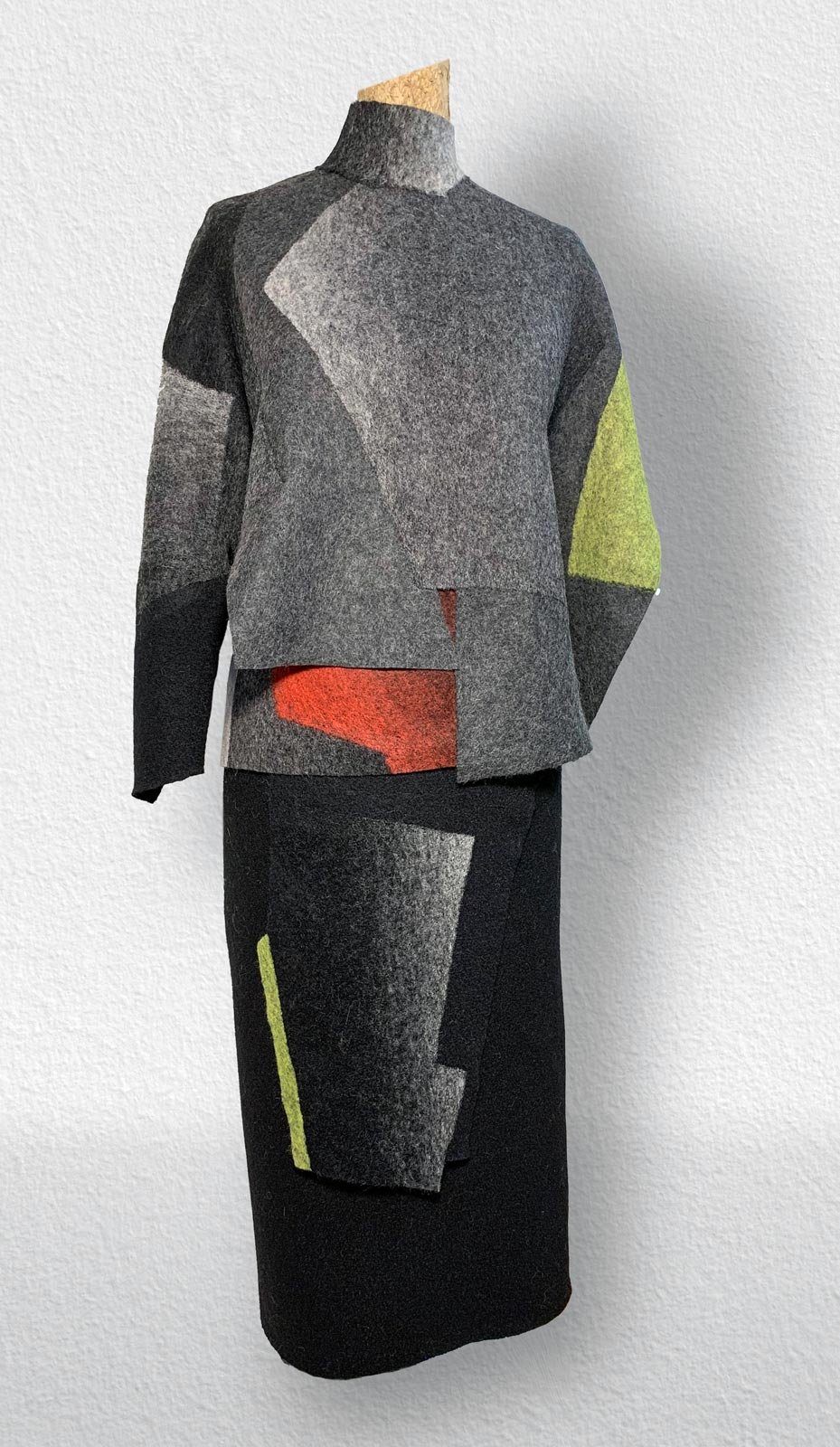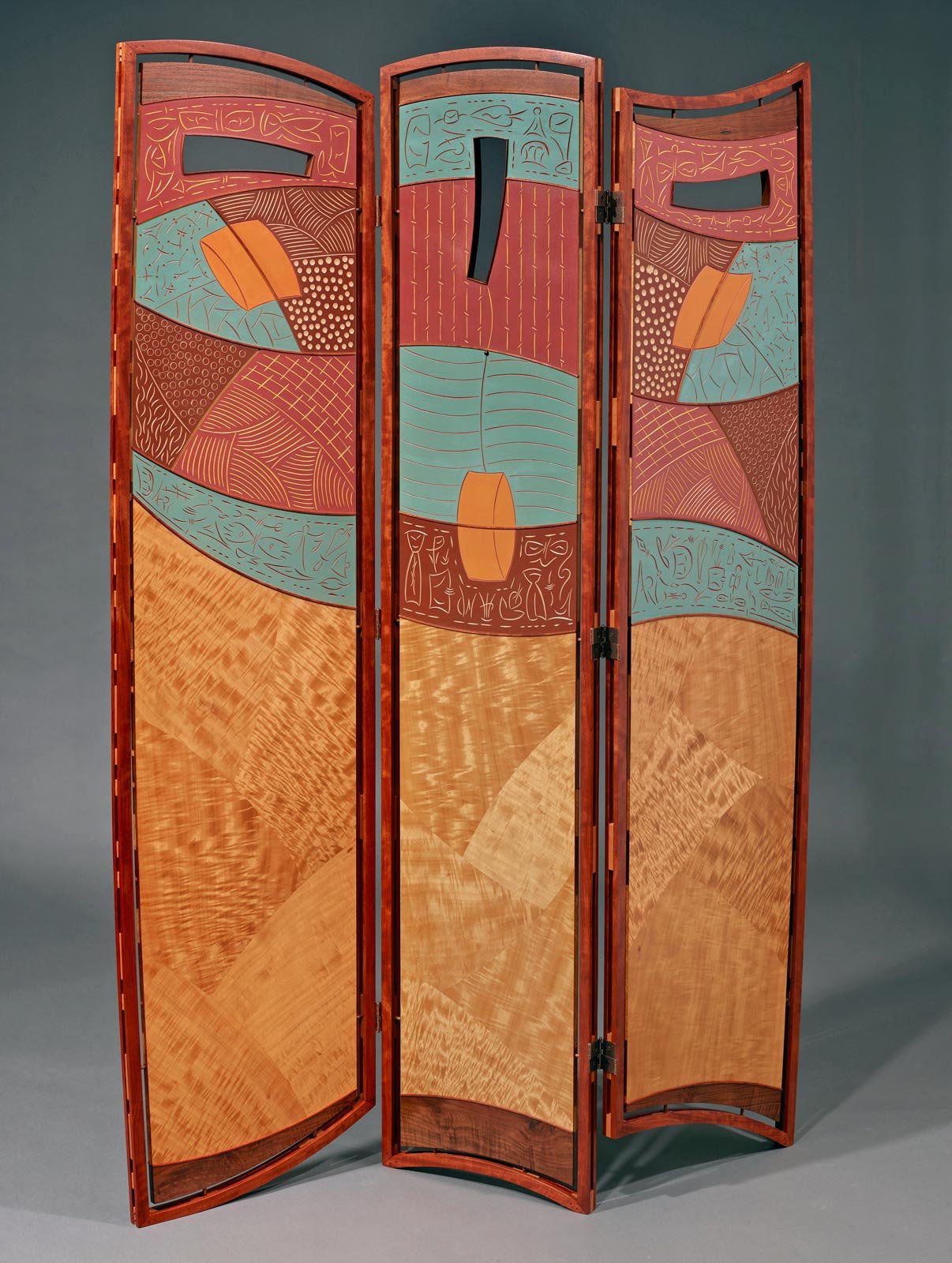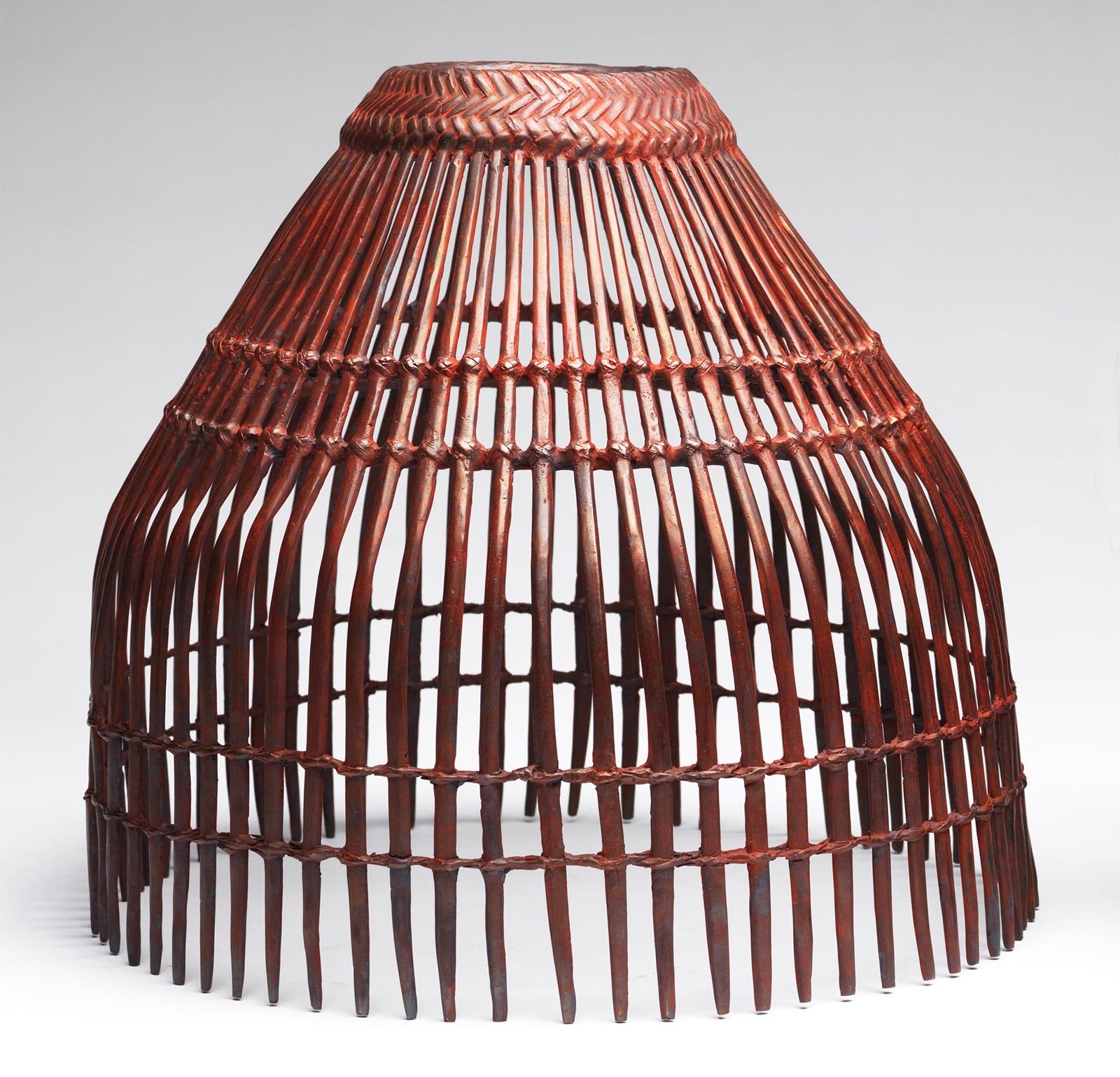Smithsonian Craft Show 2023 Volume 43.4
It’s in the air, that slight vibration of excitement, that comes from the murmur of conversation. There’s a reason human beings gather. We share our energy, our love for stories, and learning more about each other. This hum of activity is a portent of time well enjoyed, and it’s one that permeates the Smithsonian Craft Show, organized by the Smithsonian Women’s Committee.
What does this event share with the Heard Museum Guild Indian Fair & Market, covered previously in this very issue? That same opportunity for connection, of the type we’re increasingly deprived of in this modern era. In a world where technological efficiency was supposed to give us more time for ourselves, we seem busier than ever. The women of the SWC know this, and they, along with the inimitable show director Heidi Austreng, have created a haven for connection. With one hundred and twenty artists in the intimate red brick facade of the National Building Museum, you’re sure to find something rare and intriguing. The Smithsonian Craft Show gathers some of the finest craftspeople in the country, and this year they have extended invitations to Native American artists. It’s time for a shakeup, and everyone knows it, and that’s part of the beauty of this year’s grouping.
Harlan Reano and his wife Lisa Holt collaborate on ceramics drawing from Pueblo traditions, but sometimes leap directly off the rails. Their massive dragon and rabbit sculptures (can you find the rabbit in this Easter issue?) are made from fired ceramic, with bold black and adobe-colored glazes accompanied by creamy white. Holt comes from Cochiti Pueblo, while Reano is of Santo Domingo and Kewa heritage. They make ollas, the distinctive pot that serves as a common canvas for Pueblo potters. These traditions stem from customs stretching back for hundreds of years.
What we find as we meander through the show is that there’s new generations being born, new traditions to carry forward. Elyse Allen has created a small design studio that in the past fourteen years moved from bustling New York to Santa Fe, New Mexico. All the scarves, gloves and accessories are hand-knit to a luxurious softness. With a cheeky sense of humor, Allen scatters her shawls with rhinestones, like little stars against firmaments of ivory and dark, navy blue. Comfort is a vital, sometimes forgotten element of clothing, as inthe rush to transform ourselves we barrel past the tactile pleasures of clothes. Elyse Allen reminds us of these sensual qualities, which we may lack in our working day-to-day wear.
Aaron Macsai has been working as a jeweler for decades, and recently found partnership with his fellow artisan, Frances Kite, who is also a jewelrymaker, and a master cloisonné enamelist. Macsai’s work features a vocabulary of bold geometric shapes, of spirals and whorls, zigzags and leaf-like patterns. While his work was previously of metals and gemstones like gold and diamonds, his collaborations with Kite leads to splashes of color, or blacks and whites. Their work complements each other, with Macsai’s goldwork serving toprovide the frame for Kite’s enamel-painted canvas.
Click Images for Captions
Metal is taken a very different direction by Donovan Yazzie (Navajo). He tweaks with traditional Native imagery using a non-traditional material, stainless steel. He became inspired to make his own art when attending the Santa Fe Indian Markets in the mid-1980s. His more experimental pieces bring a lot together. A red, white and blue rainbow spirit meets a stalk of corn, with a yellow-faced figure sporting a turquoise necklace below.
There has always been a complex interplay between Native artisans and white Westerners. Appropriation of culture is a real thing, from cheap imitations of Native jewelry found in some less reputable galleries and gift shops to higher level work by Caucasian artisans, who use misrepresentation to present themselves as being authentically Native. However, the key injury is in the deception, and the profiting off of a people’s identity. Keoni is clear that his work is inspired by indigenous artistic traditions from around the world, yet the presence of his own technique, and aesthetic sensibilities, make it his own. Using primarily sugar maple, he takes the block of wood, carving it into an oval shape on his lathe. Next, he hollows or otherwise forms the wood into its final shape, whether that’s an imitation of a flat basket, or his tribute to “burden baskets”, a ritual item meant for guests to leave their worries behind. Designs are then burned into the wood, bold India inks are applied, and the finished piece stands in all its trompe l’oeil glory.
As our world grows smaller, conversations like these will grow to be more common, and navigating those rocky shoals requires communicating and listening, the give and take which seems so fraught in today’s chaotic environment. The arts and crafts are the perfect arena for this most difficult of human endeavors because those involved are united by one thing; the knowledge of what it takes to create a beautiful object.
“But perhaps the most radical element of the show hides in plain sight. Craft is, at its essence, a humane and human act. It is a process which celebrates the best traits we have, and conserves knowledge and skills for future generations. For those who practice it, it acts as a bridge between different cultures, as makers recognize the quiet camaraderie of techniques and materials.”
Click Images for Captions
MARY LEE HU AND CHUNGHI CHOO are being honored this year as Visionary Artists in Metal. The Visionary Artist Award, established in 2014 with award winners Wendell Castle and Albert Paley, is a vehicle for recognizing and celebrating great masters of American craft. This year’s recipients represent two very different yet inspiring approaches to their medium.
Mary Lee Hu is well known to Ornament readers for her intricate and ethereal woven wire jewelry. Having taught metalsmithing at the University of Washington from 1980 through 2006, Hu has made an indelible imprint on a generation of metalworkers in the Pacific Northwest. Her continuing refinement of her woven wire technique demonstrates the eloquence that can be reached by fully mastering a specific style.
Chunghi Choo, receiving recognition in a recently published book entitled Chunghi Choo and Her Students: Contemporary Art and New Forms in Metal, edited by SWC friend Jane C. Milosch (to be reviewed in a future issue), has experimented with multiple types of media over the years, including tie-dyed textiles and jewelry. This year’s Visionary Artist Award celebrates her hollowware, which often seems wrought from a single continuous surface. Mindful of the impact of forging on metalworkers’ health, Choo also developed her signature “silent forging”, where metal is slowly bent by hand, with steady pressure.
The new Delphi Award, first presented to Steven Young Lee and Roberto Lugo in 2021, seeks to elevate mid-career artists and recognize their hard work in their field. Amber Cowan takes broken and vintage scraps of glass, and reworks them into large-scale sculptures. She graduated with a master’s degree in glass and ceramics from the Tyler School of Art at Temple University, and received additional education at the Corning Museum of Glass and the Pilchuck Glass School. She draws from a wide toolbox of skills, such as Venetian soft glass sculpting, glass blowing and flame-working to take the detritus of American glass factories and give them new life. Ornament salutes these two Visionary Artists, and Delphi Award Winner, for their contributions to American craft.
The calm, static beauty of a painting comes to electric life in the coats, skirts and jackets made by Mina Norton. This canvas is worn, rather than residing on one’s wall, with the wearer as active participant. Norton’s fine art background plays out in her felted garments, hand-dyed to present luxurious gradients that are delineated with strong lines. Contrast is key, here, and splashes of color titillate the eye, making it dance across the sultry flow of dark greys, fading to that grayish light one experiences in the early morning hours. Norton’s clothing sings with the wearer, transforming them into an entity both playful and yet dignified. Norton immigrated to the United States from Iran in the early 1980s, and it’s hard not to acknowledge how much richer we are for her presence. The Smithsonian Craft Show is full of these examples, just like America herself.
As modern life threatens to carry us away in its rushing tide, events like the Smithsonian Craft Show serve as an oasis, and a reminder that good things cannot be taken for granted. A show like the Smithsonian takes a lot of work, from the Smithsonian Women’s Committee volunteers who woman the ticket counter, patrol the aisles and offer booth-sitting relief for that artist who needs to grab a quick snack, to the workers who set up the electricity and structures, to the artists who have spent decades honing their craft, only to lug their displays, lighting and artwork across the nation to set up for a few wonderfully hectic days. As we are provided with enough entertainment to bury us alive from our digital devices, it’s worthwhile to ask why we’re not happier. That answer is simple and straightforward: we need to be with people, and be immersed in all the pleasures of the physical to be truly alive. A craft show is more than a momentary distraction. It’s a conscious space, carefully planned, to bring us together and offer us a buffet of brilliance from our fellow human beings that we can, possibly, take home with us.
As we go further into the twenty-first century, let me make a prediction. AI art and the virtual world will continue to develop at a dazzling pace, overwhelming us with its wonders, but we’ll learn that there’s a substance missing that we yearn for. Slowly, we’ll recognize the islands in the racing current for what they are, havens of humanity that bring us closer to happiness than we’ve ever been with our many digital delights. People will make more of these islands, and we will flock to them.
That doesn’t mean that in this everevolving world there isn’t room for growth and change, and the Smithsonian Women’s Committee recognizes that. This year is the second time the show has actively courted Native American artists, in recognition that greater inclusivity showers us all with its gifts. That’s why this year is a true celebration of the American Spirit.
It also shows an effort to wrangle with the political and social issues of our time. In an era where atomization and division have been elevated to the forefront of the national zeitgeist, the decision to invite those who have traditionally been segregated from the contemporary craft scene takes on a new importance. This isn’t the first act that the Women’s Committee has taken on issues of global import. In 2021, they hosted Craft Optimism in lieu of the in-person Smithsonian Craft Show as a way to draw attention to artists whose work focused on sustainability and the natural environment. The annual Honoring the Future Sustainability Award also helps focus the public’s attention on craftspeople seeking to live in harmony with the earth.
But perhaps the most radical element of the show hides in plain sight. Craft is, at its essence, a humane and human act. It is a process which celebrates the best traits we have, and conserves knowledge and skills for future generations. For those who practice it, it acts as a bridge between different cultures, as makers recognize the quiet camaraderie of techniques and materials.
AMBER COWAN
And for us, the visitors to the show, the simple pleasure is in enjoying the work. The wealth of beauty that surrounds us stirs our imaginations, connecting us to memories held dear, or reminding us of secret wants. Mark Del Guidice speaks to the zany amongst us, those who wish to be surrounded by furniture that could come from another world. With asymmetric shapes and bright colors, these wooden screens and drawer-laden tables could come from an ancient civilization, or perhaps an alien species. He inscribes his work with etched patterns and strange hieroglyphs, lending an air of mystery that calls out to those receptive to it.
It’s also the conversations that we can have with the artists that are enriching. Bruce Schuettinger is also a furniture maker, with a previous life restoring antique and historical furniture and artifacts. His Professional Associate certification from the American Institute for Conservation in 1993 cemented his expertise, and knowledge of, traditional styles of woodcrafting. Few people have this background, and Schuettinger is glad to share his encyclopedic wisdom. Take that step and introduce yourself; the rabbit hole you’ll be led down will be gratifying, indeed.
Robert Wing represents a different arm of furniture-making, whose graceful, sensuously smooth rocking chairs are deeply inspired by the contributions of Sam Maloof. These perfectly sculpted recliners almost feel like musical instruments in their curvaceous grandeur. The simplicity and elegance of their structure, though, belies the hours and hours and hours of work that went into their construction.
You don’t have to just admire from a distance at the Smithsonian Craft Show. In an era of real democratization, these objects, once only available to the elite, are available to you, too. The impact of a well-loved object of craft reverberates beyond simple possession. When you take home a piece of craft, purchased from the artist, you’re bringing a little of that spirit into your abode with you. The intentions of that person who made the work, the love and effort they put into making this brooch, or that jacket, or this metalwork basket, resonate with you, if you’re receptive to it.
So take that radical act. Go to the show! Revel in your humanity, and those of others. Take back that real-world connection, chat with those around you, learn something new. And maybe, just maybe, you’ll find that piece of art that speaks to you.
Click Images for Captions
Patrick R. Benesh-Liu is Coeditor of Ornament and a lifelong participant in his parents’ creative journey. From growing up in the Ornament office on La Cienega Boulevard in Los Angeles to his first administrative work in the Vista, California building during high school, Benesh-Liu has had the fortune of being immersed in craft, culture and wearable art. In this newest issue of Ornament, he has the opportunity to write about two of his favorite shows, the Heard Museum Guild Indian Fair & Market in Phoenix, Arizona, and the Smithsonian Craft Show in Washington, D.C. Together these two shows are a riotous blend of traditional and contemporary, embracing a wide assortment of cultural backgrounds. Despite their aesthetic and artistic differences, he sees the underlying connectivity of human creativity speaking at both venues. Benesh-Liu also writes Passages, to remember the full and powerful contributions of founding Renwick Gallery director Lloyd E. Herman to the crafts field, and to his friends and colleagues whose lives he enriched.













